How To Build Interlocking Retaining Walls
Interlocking retaining walls rely on a series of flanges or pins and grooves that fit into one another. These interlocking wall blocks are simple to lay and strong — even without mortar. With each course fitting snugly into the one before, this is an ideal system for retaining wall contractors. Process Involved to Build an Interlocking Retaining Wall Lay Out Wall Measure out where you’ll place your wall and create the trench for the first layer of interlocking wall blocks. Run a piece of a line along the length so that you can properly align each block. Spread Landscape Fabric Walk to the top of the slope and start laying landscape fabric a foot before the drop. Weigh the edges down and spread over the top of the hill. You may need several pieces of cloth — simply overlap them and weigh each edge down. Place First Row of Gravel Next, place four inches of gravel into the trench and spread it evenly. Tamp it down. Lay First Course of Interlocking Retaining Wall Blocks Check the manufacturer’s instructions here. Most companies suggest placing the first row back to front. Now set your first row, ensuring that each block squares up to the one next to it. Gently tap with a rubber mallet to secure in place, ensuring that each block is level with the next. Set Remaining Courses Now it’s time to lay the remaining interlocking blocks. Retaining walls at this point seem to build themselves as long as you follow the manufacturer’s recommendations. With interlocking retaining walls, it’s common to offset each alternate course by half or at least three inches. This improves the strength of the design. Set Up Drainpipe When you lay the third lot of locking blocks for retaining walls, start filling the gap between the wall and the slope with gravel. When the gravel reaches the second course, lay your drainpipe with the holes facing the ground. Place the outlet in a spot away from the wall itself. Backfill Wall Cover the pipe in gravel and continue to do so with every successive course for your interlocking retaining walls. Tuck Fabric Tuck the fabric when you’re close to completing the job. With one or two layers to go, fold the fabric over the gravel backfill and secure it behind the interlocking concrete blocks retaining wall. Tamp Soil Finish off the gravel layer by covering the landscape fabric with three inches of topsoil. Then, resod the area and plant as usual. Apply Adhesive to Finish Your Interlock Block Retaining Wall It’s now time to place the adhesive on the last course of interlocking blocks. Place Capstones The final step in making interlocking block retaining walls is to lay the capstones. Check the manufacturer’s recommendations for information on squaring the stones and adhering them. Finish Base Now spread out any topsoil that you have left. Pay attention to the base of the wall, and make sure that you fill in any gaps. Evenly spread out what’s remaining and tamp it down before putting down sod or planting. Materials Needed to Build Interlocking Retaining Walls Work gloves Shovel or mattock Brick chisel and small sledgehammer Level Wooden stakes String and a line level Soil tamper Gravel (sharp, not rounded) or rock dust Interlocking stackable stones and toppers Contact Us for a Quote! Do you need help building interlocking retaining walls? Call New Life Rockeries at 206-489-3734 today to get your free competitive quote!
What is Green Landscaping
What is green landscaping? The tongue-in-cheek answer is that it’s about using one color in the garden. However, it isn’t about color — it’s about eco landscaping. Green landscaping means working with nature to create a lush, vibrant, low-maintenance garden. An environmentally friendly landscape centers on natural feeding and watering methods to boost indigenous plants. How Green Landscaping Works Green landscaping design means centering nature. That means understanding: The climatic conditions in your area Which native plants thrive The soil conditions Natural methods to retain moisture and nourish the soil Green Landscaping Ideas Function What function will the area serve? Do you want a tidy lawn, privacy, or a scent garden? If you define the function of each area, it’s easier to choose green landscaping techniques to employ. Repetition Symmetry and repetitive elements unify the design as a whole. In environmentally friendly landscaping, you can up the ante by using repetition to create swathes of color. Shades Green landscapers also change up the shade of the leaves. Green comes in different shades to create tonal depth in your garden. Textures Look for plants with different leaves or surfaces. Juxtapose soft, fuzzy lamb’s ear leaves against slick, dark juniper leaves. Consider mixing monstera leaves with delicate garden orchids. Shapes and Sizes Play up the symmetry you created earlier by adding bushes of different shapes and sizes. The interplay of color, texture, and shape is what makes green landscaping interesting. 5 Tips for a Lush and Eco-friendly Landscape Go Native Choosing native plants is a primary tenet of eco-friendly landscaping. Such plants are capable of thriving in your local environment. They require less maintenance than imports and are less likely to get sick. They also provide a valuable resource for local fauna and insects. Use Mulch Organic mulch chokes out weeds, maintains the moisture levels in the soil, and keeps the plant’s roots cooler. As the mulch decays, it releases nutrients, making it one of the best green landscaping additions. Amend the Soil Healthy soil makes for healthy plants. Keep the nutrient level up by composting garden cuttings, wood shavings, eggshells, fruit scraps, and newspaper or cardboard. These materials will break down over a few months to form nutrient-rich compost. Be Water-Wise Reduce your water requirements by planting water-wise plants, harvesting rainwater, and using mulch. Water during the cooler parts of the day to reduce evaporation. Utilize Hardscapes Terraces and retaining wall contractors can create areas for planting to extend the usefulness of slopes in the garden. Advantages of Green Landscaping Provide Cooler Temperatures Mulch keeps the surface temperature of the soil cooler. Good for the Air and Water Natural composting methods reduce the number of artificial chemicals in your soil. The natural loam filters out impurities in the rainwater, and your plants receive cleaner water. When they respire, they breathe out purer air. Outdoor Living Areas Improve Quality of Life Being out in nature is the ideal way to relax and play. You can entertain, have a quiet romantic dinner, or spend time solo. Retaining Walls Prevent Erosion Retaining walls propping up terraces of plants form a strong defense against erosion. Is Green Landscaping the Answer for You? Call New Life Rockeries at 206-489-3734 or reach out through our website for your green landscaping contractor consultation.
The Dos and Don’ts of Landscaping Around Trees
Landscaping around trees is tricky, thanks to their extensive root systems. It’s easy to damage these delicate networks and harm the tree. Fortunately, if you understand the dangers, you can work around them. Here the team at New Life Rockeries share their best do’s and don’ts for landscaping around large trees. Landscaping Around Trees Ideas: The Do’s of Landscaping Around Trees There are several exciting options for landscaping borders around trees. Calming Cohesive Garden There’s nothing more relaxing than spending an afternoon in the shade of a beautiful tree. Turn this space into a charming feature by adding a bench or chair. Then, cordon the area off with river rock landscaping around trees with locally sourced rocks. A Sandstone Cobble Border Landscaping around trees with rocks is a simple way to accent trees beautifully. A sandstone border takes landscaping around trees with stone to the next level because of its honeyed tones. The cobble border is ideal for those with little time for gardening as it’ll choke out weeds. Leave a space of around 10 inches between the trunk and stones to allow for growth. Low Stacked Stone Raised Bed If you find a cobble border a little too formal, a stone raised bed is one of the alternative ideas for landscaping around trees. Instead of using uniform pieces of sandstone, you use locally sourced rock. Create a small ring around the tree by piling each stone on top of the other. You’ll achieve a rustic, natural look. Be sure to use a landscaping fabric under the rock so that the ground can still absorb water. Underplants Creating a grove at the foot of a tree is a gorgeous feature. You must carefully research which plants best suit landscaping ideas around trees with underplanting. The plants will grow in relatively shady conditions, so ferns, hostas, and coral bells may be good options. Steel Planter Edging Steel planter edging is the contemporary alternative to landscaping around trees with bricks. As the steel band border ages and oxidizes, it creates a striking design. Don’ts of Landscaping Around Trees Don’t Damage Tree Roots When planting plants, dig carefully to avoid damaging the tree roots. Use a small trowel and scoop out the soil rather than shovel it out. Don’t Pile Mulch Mulch is good for the soil and can protect roots. It also acts as a cover for pests and mold. Start applying the mulch at least 10 inches away from the tree trunk for best results. Don’t Use Solid Plastic Sheeting Solid plastic sheeting is useful in construction because it creates an impenetrable barrier. However, when you’re planting a garden around a tree, it’s harmful. Instead, use a porous fabric that allows water to trickle through to the tree’s roots. Don’t Crowd the Tree With a Deck or Patio Trees grow faster than you might realize. When building a deck around one, leave at least two to three feet around the trunk to allow for more growth. Don’t Neglect the Nighttime Scene Enjoy your work night and day by placing some solar lights to “paint” the tree. Do You Need More Information on How To Landscape Around Trees? Call New Life Rockeries at 206-489-3734 today to discuss your options. As specialists in our field, we make landscaping around trees, paths, or pools simple. Let us help make your garden magical with a landscaping contractor.
Retaining Wall Ideas for Sloped Backyard
Building your home on a slope allows you to maximize your use of space. With proper support underpinning your house, the soil stays in place and prevents slippage. It’s here that retaining wall contractors idea for sloped backyards can improve the look and functionality of your home. Not only does a sloped retaining wall prevent soil runoff, but it also provides additional stability for the entire structure. Retaining Wall Ideas for Steep Slopes Ideas to Stabilize Steep Slopes Building up stacked stone pieces is one of the top retaining wall ideas for a sloped front yard. The wall looks natural, holds firm, and the spaces between each block provide natural drainage. Choose stone in a color that matches your home, and it’ll blend perfectly. Ideas of Retaining Wall and Stone Path in Steep Slope Backyard Cost-effective stone retaining wall ideas for sloped backyards do not necessarily have to provide full coverage. A 2-3 foot curved wall with a retaining path running through it improves the area’s look and utility. Low Stucco Retaining Wall This retaining wall idea makes for a more intimate space. Build your home-matching stucco design along the length of the garden in straight or curved stretches to create courtyards and distinct areas. Terraced Style Retaining Wall Terraced rock walls create several beds at different levels for planting gardens or other outdoor ideas. Retaining Wall Doubles If space is at a premium, it makes sense for your retaining walls to do double duty as seating. Top your wall with flat stones to complete the effect. An Eichler Remodel This style incorporates patches of flat space interspersed with slopes. Contemporary Metal Retaining Wall Landscape A steel retaining wall is a statement piece that develops a beautiful patina as it oxidizes. Stepped Retaining Wall Ideas A stepped wall is useful for gradual slopes. Instead of the wall being all one height, it “steps” down at regular intervals. Rustic Retaining Wall Ideas Rustic walls consist of stones sourced locally and roughly finished. The idea is to make them a similar size and shape, but not perfect. Modern Hillside Retaining Wall Using pressure-treated timber lends a natural but contemporary look. Benefits of Retaining Walls Retaining walls on slopes serve both practical and aesthetic benefits. Prevent Flooding With A Retaining Wall Without a retaining wall for a sloped backyard, there is nothing to stop water from rushing down the bank. It’ll flow to the lowest part of the yard, causing flooding. A retaining wall reduces the risk by controlling the moisture. Retaining Walls Can Add an Attractive Element You may choose many finishes to make your wall your home’s perfect match. A Solid Property Boundary Marker A sloped backyard retaining wall makes it easy to see where your property ends. Slow Down Soil Erosion With a Retaining Wall Why are retaining wall ideas for a sloped backyard so popular? They actively prevent soil displacement by acting as a catch-all. The soil doesn’t wash away because of the barrier. Make Better Use of Your Available Landscaping Space Planting a heavily sloped area can be challenging. Unless you can keep the dirt in place, you risk rain washing away your new plants. Retaining walls can prevent that from happening by holding the soil in place. Learn More About Beautifying Your Backyard Call New Life Rockeries today to discuss stabilizing and beautifying your slope. Find out which cost-effective retaining wall ideas for a sloped backyard will work for your home by calling 206-489-3734 or completing our online form.
Best Way to Getting Rid of Moles Fast Out of Your Yard
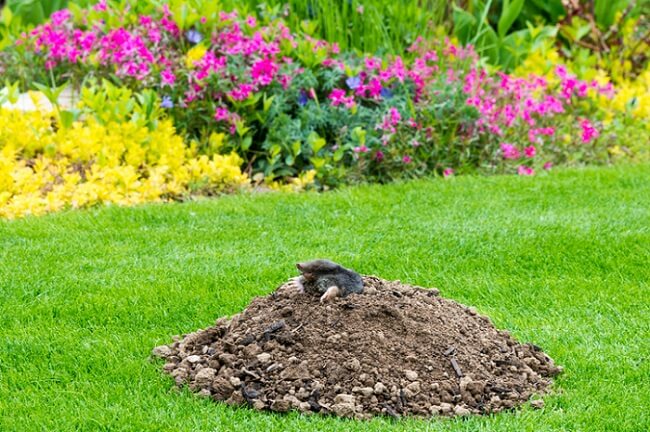
Moles can cause a lot of damage. Learning how to get rid of moles in the yard fast can come in handy when you discover those small, volcano-shaped mounds of soil in your lawn. If you’ve ever searched for “how to get rid of moles in my yard?” this post is for you. We’ll discuss what moles are, signs you have them in your yard, and how to get moles out of your yard. Let’s start with the basics. What Are Moles? Moles are mammals that live underground. They’re efficient diggers and spend a lot of time digging tunnels in their hunt for mostly worms, bugs, and grub. While most of their excavation is below the surface, they push mounds of soil to the surface, creating unsightly holes and weak spots in the lawn. As they tunnel for food, they can disrupt the roots of vegetables and other plants. Sign of Moles in Your Yard Most people confuse mole damage with damage caused by rodents, voles, or mice. Watch out for these signs: Dead grass: Moles can cause damage to grass’s roots when they burrow close to the surface, leaving dead patches of grass in their wake. Mounds that are far apart: Numerous creatures can cause soil mounds in your yard. Gophers, for example, make entrance and exit mounds that are close together. Mole mounds tend to be about six feet apart, and the soil is finer than that of a gopher mound. Volcano-shaped or cone-shaped molehills: When moles dig tunnels, they push the dirt straight up to the surface, creating a tell-tale volcano- or cone-shaped mound. How to Get Rid of Moles in Your Yard Moles spend their entire lives in their tunnels, so they prefer areas with loose soil ideal for feeding, burrowing, and breeding. That said, they’re attracted to places with lots of bugs and worms, cool temperatures, and landscaping elements such as paths, fence rows, and other types of borders. What Is the Fastest Way to Get Rid of Moles in Your Yard? Once you realize you have a mole problem, here are some effective ways of getting rid of moles in the yard. Eliminate their food sources: Using various methods to control or repel insects and worms is the best way to get rid of moles in your yard. Use mole repellents: Mole repellents typically produce certain smells that keep moles away. Castor oil is an effective mole repellent. Mole trapping: Mole traps offer a sure-fire way to deal with an existing mole problem. Other options to consider include: Digging a trench Creating an unfriendly environment Using baits Seattle Landscaping Experts Near You! Now that you know how to get rid of moles in your yard, you can take proactive steps to keep them away. Should you need professional assistance, seek the help of an experienced contractor. At New Life Rockeries, we’re proud to offer an extensive range of landscaping services. Contact our experts today if you need help reducing, controlling, or eliminating moles from your yard. Feel free to dial (206) 489-3734 or fill our online contact form for a free quote.
Front Porch Landscaping Tips for Your House
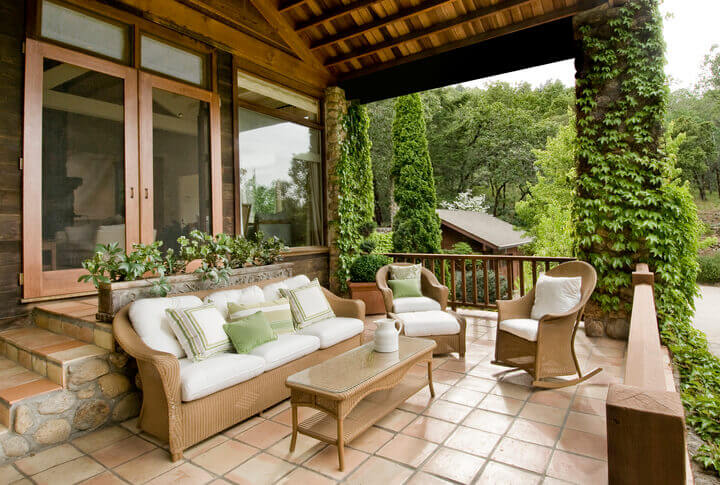
Your front porch is a crucial part of your home’s curb appeal. Regardless of your home’s architectural style, you can complement your home’s appearance with proper landscaping. Fortunately, there are plenty of landscaping ideas for the front of a house with a porch. Have you ever asked yourself the question, “How do I make my porch cozy?” In this post, we’ll outline a few innovative front porch landscaping ideas that can improve your home’s curb and aesthetic appeal. Whether you need front porch garden ideas or front porch flower bed ideas, we’ve got you covered. Most of the tips here can work with large or small front porch landscape ideas. 10 Amazing and Breathtaking Front Porch Landscaping Ideas Flower Beds Make your front yard flower bed stand out. Mix evergreens with colorful plants and consider giving the flower bed a rustic feel by adding accent details. A curved flower bed lends a more natural and welcoming feel than a straight-edged rectangular flower bed. Fencing If you have a tall privacy fence, you can fill the area covered by the fence with built-in planters containing your favorite flowers and plants. Arch There’s something very welcoming about arches or arbors. Find one that complements your front porch and makes it more inviting by surrounding it with beautiful flowers or shrubs. If possible, try to integrate the arch into the design of your fence. Walkway Walkways don’t always have to be straight or boring. Consider interesting and intriguing walkway designs, like a winding brick or flagstone path. With so many materials to choose from, go for options that reflect creativity or personality. Lighting Thoughtful landscape lighting can make your front yard stand out. You can use landscape lighting to create interesting shadows and highlights that accent nearby plants. Pond Don’t shy away from adding ornamental value to your pond with fountains, waterfalls, or other features that make it unique. Use decorative rock and simple shapes to give an illusion of depth. Hanging Baskets Hanging baskets are well-suited to decorating your front porch because they allow you to add color and fragrance. Consider mixing and matching a variety of flowers for maximum impact. Garden Making a garden bed around your mailbox can add color and personality to your front porch. Plant some annual flowers next to your mailbox and make a simple border. Even if you use a different material for the garden bed border, adding stones or rocks can help create a natural accent and break up the profile. Planting When choosing front porch landscaping ideas, think about plant sustainability. Consider perennials for their low maintenance. Moreover, the plants don’t have to be diverse to make an impact; there’s no harm in using repetition and symmetry to add some formality. Front Porch Landscaping Contractor Near You! With the front porch landscaping ideas mentioned above, you can make your front porch the talk of the neighborhood. Are you looking for landscaping contractors you can count on? Contact New Life Rockeries today for a free quote. Feel free to give us a call at (206) 489-3734 or fill our online form to get a free quote. We look forward to helping you with your landscaping project.
Retaining Wall Types for Effective Landscaping
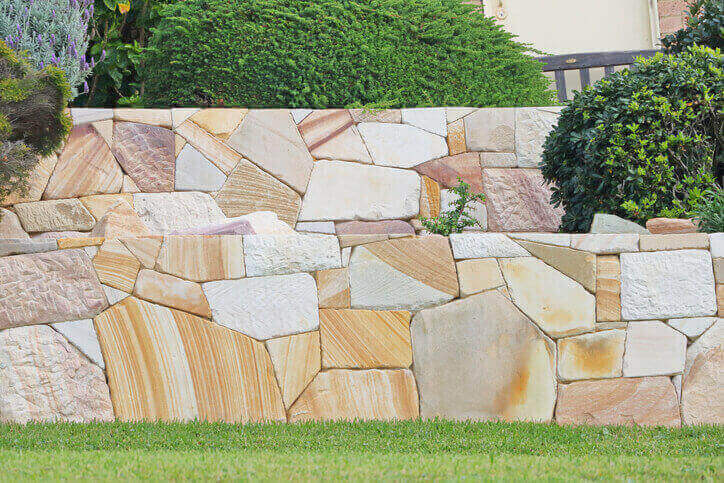
There are four basic types of retaining walls, each with a unique appearance, durability level, and lifespan. Whether you’re considering having a retaining wall installed for practical or aesthetic reasons, New Life Rockeries’ team of landscape professionals can help you find the perfect addition for your outdoor space. Continue reading to learn about the different types of retaining walls or contact New Life Rockeries today with your landscaping questions. The 4 Different Types of Retaining Walls The type of retaining wall you choose for your landscape will impact the overall aesthetics, practicality, and feel of your space. This is why understanding the different types of retaining walls will aid you in choosing one that complements your space while also improving outdoor functionality. The four main retaining wall types are detailed in the following sections. Cantilever Retaining Wall A cantilever retaining wall (sometimes referred to as a reinforced retaining wall) has steel bars that run through it that affix it to its foundation (usually a slab foundation buried beneath the soil). Due to its foundation, this type of wall is highly durable and is often used for commercial retaining walls. Gravity Retaining Walls One of the most common types of outdoor walls, gravity retaining walls rely on their own mass to contain soil. Blocks, pavers, and unmortared stone are all used to build gravity retaining walls — ensuring that they are stylistically versatile while also being durable. Anchored Retaining Walls The method of anchoring a retaining wall is done by placing anchors beneath the soil and attaching cables or strips to support the facade of the wall. This method creates a durable, highly-versatile retaining wall that matches any landscaping style. Anchoring also enables the wall to support more weight — making it perfect for preventing soil erosion. Piled Retaining Walls One of the most basic kinds of retaining walls, piled walls take up minimal space and are ideal for landscapes that need a wall but don’t have room to construct a bulkier type of wall. Piled retaining walls do best in soft soiled landscapes and often need a vertically corrugated structure to provide additional support. Reasons to Have a Retaining Wall Installed Retaining walls are a practical and stylistic addition to any outdoor space. Some of the main benefits of having a retaining wall installed include: They add texture to your space. They divide up your landscape. They prevent soil erosion. They assist in landscape drainage. They are stylistic additions. Choosing a Reliable Retaining Wall Installation Service Near You! If you have additional questions about the different retaining walls available or you would like to receive an estimate for having a wall installed at your residence, get in touch with New Life Rockeries today. Our team of landscaping near me specialists would be happy to help you choose a retaining wall contractors, style, and material to ensure that you get the best possible addition to your landscape.
What Is the Best Retaining Wall Material?
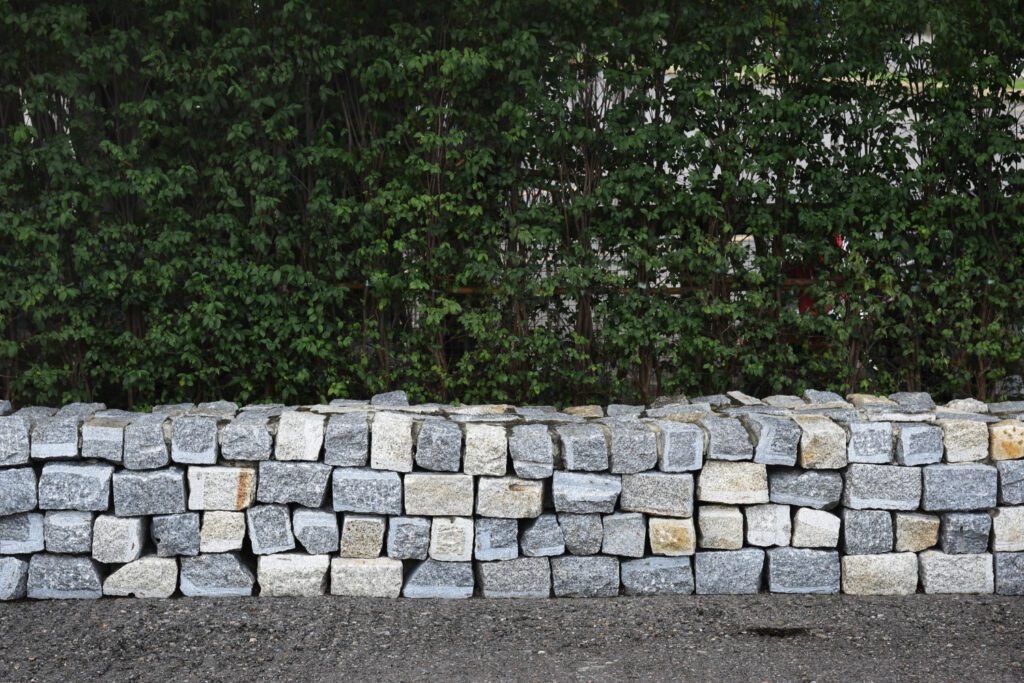
When it comes to retaining wall materials and how to choose the best one for your landscape aesthetic, you’ll be glad to learn that you have a lot of options. Retaining walls are popular throughout Pacific Northwestern landscapes for a number of reasons. Firstly, they prevent soil erosion — which can alter and deform your landscape significantly. Secondly, they enhance landscape drainage, ensuring that your yard stays dry and firm. Thirdly, retaining walls add texture and dimension to your outdoor aesthetic. If you’re in search of the best material for retaining walls, continue reading or get in touch with New Life Rockeries today to speak with a landscape professional. Strongest Retaining Wall Materials Whether you are looking for the strongest or cheapest material to build a retaining wall out of, the following sections contain a brief overview of the various materials that can be used for your wall. Wood While wood is a more accessible material and is DIY-friendly, there are a number of drawbacks to having a wood retaining wall. Due to the damp environment of the Pacific Northwest, wood retaining walls are likely to rot and decay at a much quicker rate than other materials. If longevity isn’t a hang-up for you, wood retaining walls make an excellent choice for almost any landscape as they are stylistically diverse and naturally beautiful. Concrete Block Concrete blocks provide a monotone retaining wall that can stand up to four-feet tall. Blocks can be used to create curved walls and are a popular choice for homeowners who enjoy a mid-century architecture style. Two downsides to concrete block retaining walls are that they cannot be taller than four feet and that their lack of footings could affect their durability. Poured Concrete Poured concrete retaining walls are sleek in appearance, complimenting modern landscape designs. Concrete retaining walls are stronger and more durable than concrete block walls but may crack under certain conditions. This type of retaining wall is also not a DIY project and requires a skilled professional to build. Brick Classic, strong, and aesthetically pleasing, brick retaining walls are among the most popular due to their durability and traditional style. As with many retaining walls, brick walls require lots of skilled labor and are not usually suitable for DIY installations. Stone Veneer Stone veneer provides a unique, natural-looking retaining wall that is highly customizable. A benefit of stone veneer is that it is relatively durable and any height of retaining wall may be built using it. How to Choose the Best Retaining Wall Backfill Material The best backfill material for retaining walls depends a lot on how good your landscape’s drainage is, how much rain your yard receives, and other factors. In general, three of the best retaining wall backfill materials include: Gravel Aggregate Native soil Ideal base material for retaining walls is crushed rock. Contact a Custom Retaining Wall Installation Service Near You If you are in need of additional tips for choosing a retainer wall material or you would like to get a quote for your retaining wall contractors for your installation needs, get in touch with New Life Rockeries today. Our landscaping specialists would be happy to discuss retaining wall material options with you to ensure that you get a retaining wall that reflects your character and style.
What Material To Use Between Flagstones on a Patio
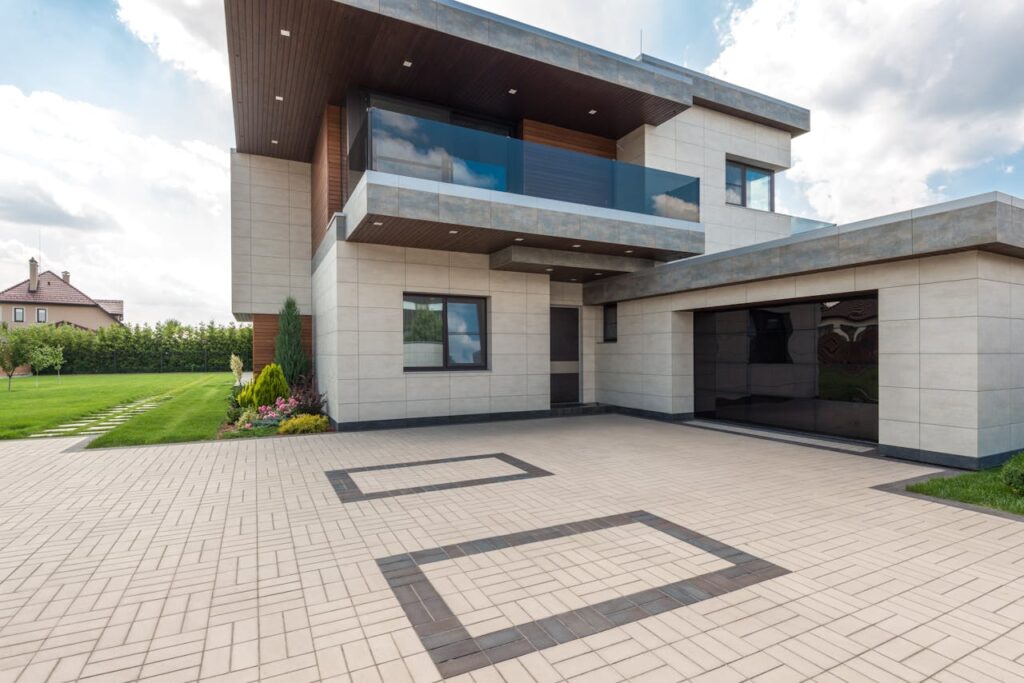
Installing a flagstone patio is one of the best improvements you can make for your outdoor space. It adds contrast, texture, and visual design while also contributing many practical benefits. Read on to learn more about what is the best material to put between flagstones on your patio or get in touch with New Life Rockeries to speak with a professional patio installer about your outdoor needs. What to Put Between Flagstones on a Patio Whether you’re planning on installing your own flagstone patio or you’re going to hire a professional installer to do it, understanding the best material to have between your flagstones is important. Not only does the material that you use affect the aesthetics of your patio, it also can affect things such as functionality, pest infestation, and the intervals at which you have to replace it. What Material to Use Between Flagstones? The type of material that you choose for your flagstone patio will depend greatly on the aesthetic that you’re going for as well as the types of practical benefits you want. Here are five types of materials to use when filling gaps between flagstones: Sand. Though a very common filler, bear in mind that if you use sand for flagstone patio filler you will need to refill it from time to time as the sand will erode. Rocks. Small stones, gravel, and crushed gravel are all commonly used as a flagstone filler. They are both a practical and aesthetically pleasing filler solution as they reduce weed growth and bug infestations. The only downside to rocks is that they don’t add any color, leaving the patio mostly monotone. Mulch. Bark and mulch are also used to fill the gaps between flagstones. The rich, dark color of the mulch serves as a stark contrast to the neutral-toned flagstones — adding yet another creative element to your patio. This type of filler also diminishes the likelihood of weed growth and pest infestation. Plants. Ground cover plants such as moss or turf make an excellent filler option for flagstone patios, and add a dash of color into the landscape as well. Turf is best suited for flagstone patios with large stones that are spaced far apart. Polymeric stone dust. Stone dust between flagstones is probably the best filler option, especially for irregularly shaped flagstones. Polymeric stone dust is specially formulated to resist erosion, reduce weed growth, and keep pests away from your patio. Get the Flagstone Patio of Your Dreams Here at New Life Rockeries, our team is passionate about helping homeowners achieve the outdoor aesthetics of their dreams, and we accomplish this through impeccable design skills and unstoppable determination. When you partner with New Life Rockeries, you ensure that you get the premium outdoor services that your landscaping near me deserves. Get in touch with us to learn more about our flagstone patio installation services or pricing.
Decomposed Granite – Uses, Maintenance and Costs
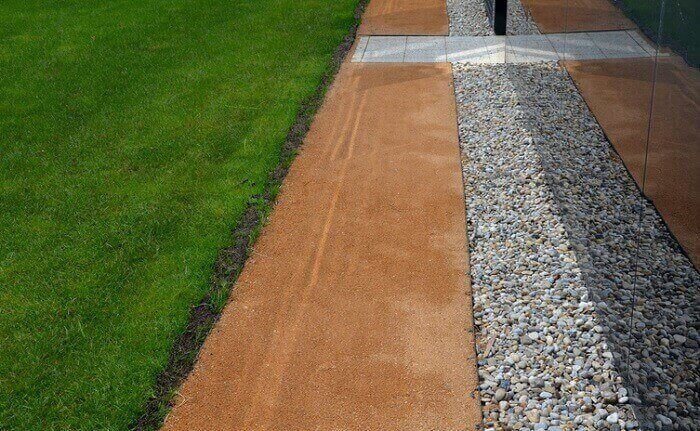
When most people hear about granite, their minds immediately go to the kitchen. No, that’s not because they have an appetite—it’s because granite and marble countertops have become a mainstay in modern kitchen design. But fewer people are familiar with decomposed granite. Exactly what is decomposed granite, you ask? In this article, we’ll be providing you with a clear definition as well as taking a look at the many uses and advantages of decomposed granite. What Is Decomposed Granite Used For? It’s likely that you encounter decomposed granite regularly in your daily travels. It’s commonly used in areas like these: Adorning pathways in a garden Local parks Pathways in local communities On a baseball field Many more It’s a versatile material that gives you a sleek looking natural surface, while remaining very firm and porous. It has an uncanny natural look that many seek out for the perfect accent to their rockery vision. Decomposed granite is, of course, a form of granite. Granite is the most abundant igneous rock on the planet, formed as magma cools and solidifies. As one may expect, decomposed granite is the late-stage form of granite. After enduring erosion and natural elements, granite will begin to flake and crumble. This transforms it into a decomposing granite material that can be crumbled into various sizes of particles, making it a versatile fit for any project. Part of what makes decomposed granite so special is one of its particles, feldspar, which weathers away into a clay mineral known as kaolin when exposed to water. Using Decomposed Granite for Your Project Decomposed granite makes a fine addition to any landscaping project. Being even harder than marble, its robust makeup makes it an ideal fit for areas like the following: Driveways Pathways in your yard Landscapes Trail networks Patios Even ballparks! Being a very robust, low-maintenance material, it’s a popular choice for projects of all shapes and sizes. The decomposed granite uses are endless. Decomposed Granite Colors Beyond just its practical applications for a project, there are many different types of decomposed granite, including a variety of colors. Typically, decomposed granite will start out a reddish tan color, gradually fading over time into a spectrum of shades. Maintaining Decomposed Granite Most commonly, folks may choose to make use of a stabilizing agent to increase the robustness of their decomposed granite pathway. New Life Rockeries has several options that we can recommend if you have a more specialized need for your decompo Decomposed Granite Cost Buying decomposed granite depends on the size and quantity needed. Please reach out to one of our talented estimators for an accurate decomposed granite price, if you’re looking to determine scope for your next landscaping project. Decomposed Granite Near Me For multiple generations, New Life Rockeries has provided its customers with immaculate results and exceptional customer service in their landscaping projects. If you’re considering using decomposed granite for your next project or have general questions, please reach out to us by clicking here.
